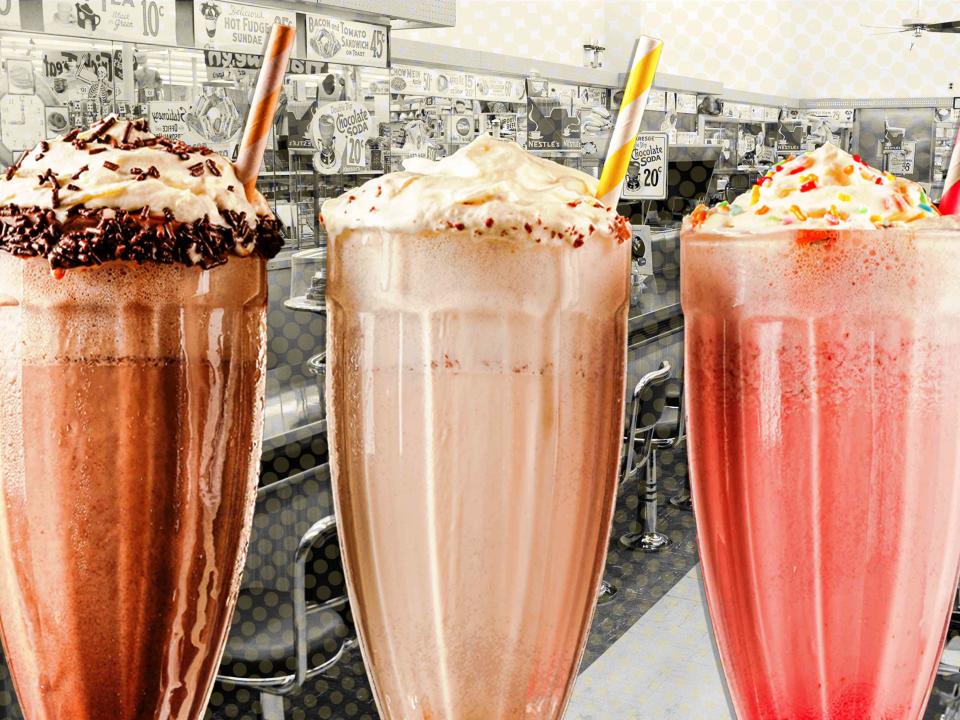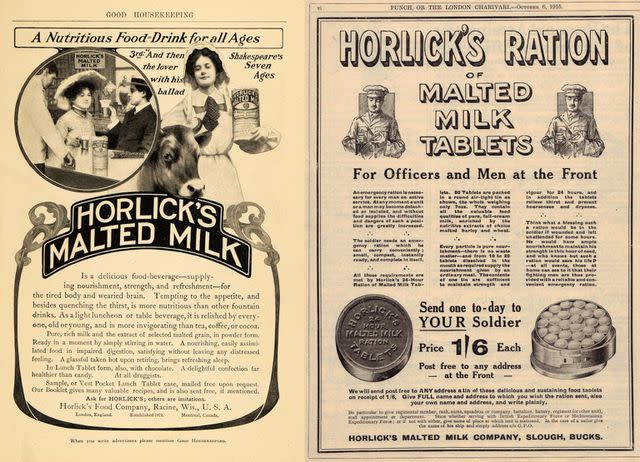Wait, Milkshakes Were Invented at… Walgreens?
The ice cream treat has a surprisingly "healthy" history.

Shutterstock
Ah, milkshakes—creamy, thick, and crave-worthy. The sweet, frosty drinks can serve as the perfect finish to a fast-food meal or just the *little treat* to give your day a boost.
It’s hard to imagine shakes any other way than the custardy, rich treats you pick up from the drive-thru, but believe it or not, milkshakes used to exist as something much more similar to eggnog than anything you’d recognize today. That is, until 1922, in a pharmacy you might be familiar with—Walgreens.
Here’s the full story of how the all-American classic shake came to be.
#Funfact: In 1922, #Walgreens invented the first malted milkshake. pic.twitter.com/aMFUQpRhXN
— Walgreens News (@WalgreensNews) July 9, 2014
What Was the Original Milkshake?
The term “milkshake” was first seen in print in the Atlanta Journal-Consitution in 1886 and it referred to an alcoholic whiskey drink made with cream and eggs, similar to an eggnog. Before the rise of the electric blender, these drinks were shaken by hand, giving the name “milk shake” a bit more context.
The milkshake took on a new identity away from boozy beverage and toward healthful tonic when a new ingredient was introduced to the world: malted milk powder.
In the late 19th century, English-born food manufacturer William Horlick developed malted milk powder as an easily-digestible supplement for children and medical patients. The all-in-one powder, made with malted barley and wheat flour, was a revolutionary new product. It could form a caloric, nutritionally-dense drink with just the addition of water.

Wisconsin 101
Better yet, it had a uniquely delicious flavor with toasty and nutty notes. So, although it was originally distributed as a health supplement, Horlick’s malted milk was quickly popularized for its taste during the 1920s.
A few short years later, in the era of the Great Depression and prohibition-America, malted milk powder became revered as an affordable, delicious source of calories and nutrients (that also happened to be non-alcoholic). Saloons were phasing out as soda fountains were phasing in. And so, the perfect scene was set for a tasty new innovation.
The Invention of the Modern Milkshake
In the 1920s, drug stores, soda fountains and pharmacies were on the rise, and almost all of them were selling “malted milk” as frothy health drinks. Milk, chocolate syrup, and malted milk powder made up the standard recipe. But one day, that all changed.
In 1922, in a Walgreens in Chicago, Ivar "Pop" Coulson added two scoops of vanilla ice cream, manufactured in Walgreen’s own plant, to the standard malted milk recipe. He coined it “Horlick's Malted Milk," but today we’d call it the very first modern milkshake.
Horlick's Malted Milk, unsurprisingly, took off. The new version had a creamy, thick, uniquely satisfying consistency that had never been tasted before. “Customers stood three and four deep around the soda fountain to buy the ‘double-rich chocolate malted milk,’” Walgreens says on its site.
Did you know we invented the chocolate malted milkshake in 1922? How will you enjoy #NationalChocolateMilkshakeDay? pic.twitter.com/XFBCuU1ulG
— Walgreens (@Walgreens) September 12, 2016
It was served in a specific way too, poured into a bulbous edge glass only two-thirds of the way full and topped with a mountain of whipped cream. The excess was served alongside it in a metal shaker, and in some joints, that's the same way you can find it today.
One final "ingredient" was essential to the country’s milkshake boom: the electric blender. In 1911, the Cyclone Drink Mixer was released by Hamilton Beach and was the first model to hit soda fountains, but it didn’t have quite enough steam to meet the milkshake demand.
In the 1930s, the heavy-duty, motor-driven 'Multimixer' hit the marketplace, changing the pace of milkshake production. The blender had five powerful spindles that could fold in more air for fluffier, softer products, and it could do so in a fraction of the time.
In the 1950s, blender salesman Ray Kroc bought exclusive rights to the Multimixer from inventor Earl Prince, then went on to sell several mixers to Richard and Maurice McDonald, the owners of McDonald’s.
And well...the rest is history.
Milkshakes vs. Malts
If you’ve ever had true malted milk, you know the flavor of malt is toasty and slightly nutty (and if you haven't, think of the flavor of Ovaltine or an Easter malted milk egg candy). While it goes well with chocolate and vanilla flavors, it's not as complementary to fruity flavors of ice cream. So, the use of malted milk powder in milkshakes was phased out as more fruit-forward milkshake flavors hit menus.
However, you can still order a "malt" at some old-school diners and get a milkshake with the addition of malted milk powder, which gives the drink the traditional flavor and an even thicker consistency.
Nowadays, there are plenty of variations on the classic ice cream treats, with flavors like strawberry, peanut butter, and even (the Chick-fil-A favorite) peach. With so many modern adaptations, fast food companies can’t even call their drinks "milkshakes" anymore—but we don’t get into that.
Milkshakes might not be the "health drinks" they used to be, but we still have Walgreens pharmacy to thank for giving America a sweet piece of its history.

